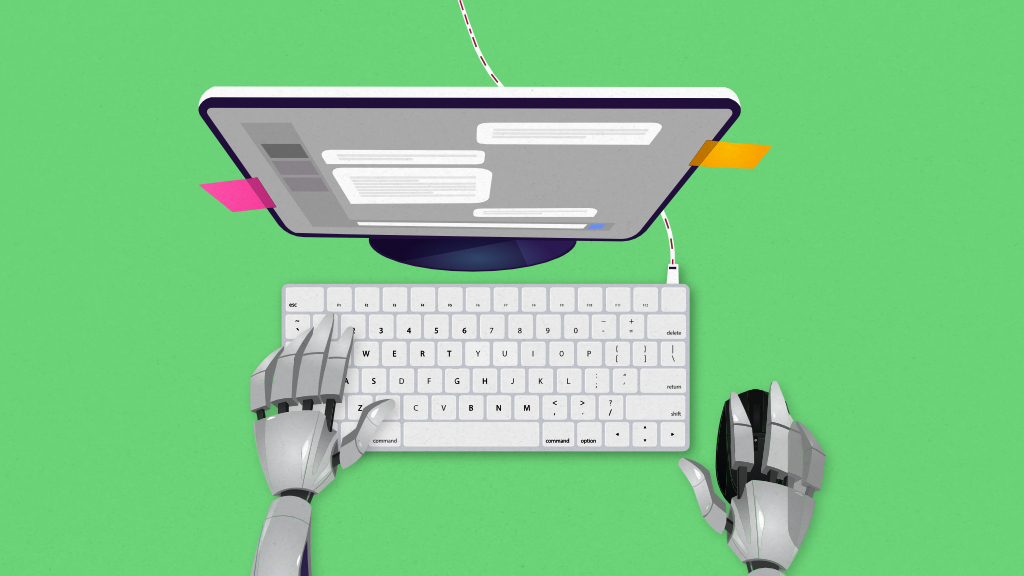AI in the workplace isn’t on the horizon—it’s already here.
From chatbots handling customer services to ChatGPT cranking out content, AI is omnipresent. It is powering the fourth industrial revolution and redefining how businesses operate.
Where there are significant benefits to AI workplaces, there are also legitimate worries about its adverse implications on various job roles and industries.
In this article, I’ll walk you through the potential impacts of AI in the workplace, its benefits, and examples. Plus, you will also explore the ways AI is influencing workplace dynamics and practical methods to stay ready for AI takeover.
What is AI in the workplace?
Artificial intelligence in the workplace refers to the integration of artificial technologies into business operations.
It is trained to perform, automate, and optimize various tasks or processes that otherwise require human assistance or intelligence. It enhances employee effectiveness, productivity, and efficiency, helping businesses operate at an optimal frequency.
Learn how AI is shaping project leaders’ roles with our comprehensive guide
How is AI changing the workplace: various applications
AI is becoming a cornerstone of success for everyone. That is apparent from its continual adoption by contemporary workplaces.
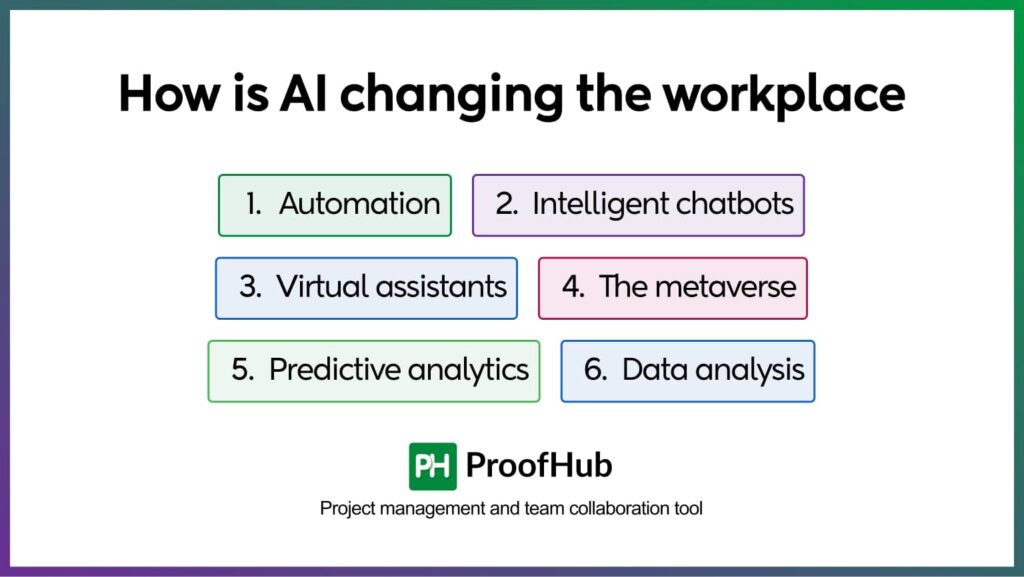
It introduces different technology applications to redefine the meaning of workforce applications and operations. Some of the prominent ones are mentioned below:
1. Automation
The prime functionality where AI assists CEOs and managers is improving their operational efficiency by automating tedious and recurring tasks. It not only increases their speed but reduces the scope of encountering avoidable human errors.
This frees employees from performing monotonous tasks, allowing them to bring their creativity into more value-driven aspects. As a result, you save your spend on your resources, like time, costs, and efforts, leading to streamlined workflows.
2. Intelligent chatbots
Chatbots and virtual assistants are invaluable assets for modern workstations. These AI-driven entities have become advanced in their ability to understand and converse beyond just saying yes or no.
These free humans from performing mundane tasks like providing instant responses, handling customer complaints, and automating routine queries. These tools enhance your workforce’s efficiency, communication, and productivity, allowing them to focus on complex customer queries and support tasks.
Streamline your workplace communication and team interactions through effective communication
3. Virtual assistants
Virtual assistants are advanced AI applications trained to perform both simpler and complex tasks.
According to Statista’s prediction on virtual assistants, the number of their usage will reach 8.4 billion units by 2024.
These versatile conversational interfaces facilitate seamless user experience by handling
- Administrative tasks, like managing email, scheduling meetings, and more.
- Project management operations, such as managing deadlines, calendars, and communication for projects
- Content creation process that includes creating social media posts, preparing presentations, and more.
Some of the popular virtual assistants include Microsoft Cortana and Google Assistants. These are much preferable where complex and sensitive data is involved.
Enhance your team’s collaboration and productivity with AI-powered team communication tools
4. The metaverse
The hype of the metaverse transition into business dynamics is quite notable now. Gartner makes a prediction stating that 25% of people will be using AI metaverse for at least an hour for their work by 2026.
The augmented reality technologies will blend into the physical workspace. From setting up 3D rooms for employee collaboration to attending meetings in a virtual world, regardless of physical location, metaverse will give your workspace an entire 360 transformation.
5. Predictive analytics
Advanced algorithmic techniques, like deep learning help managers identify trends, patterns, and correlations in vast amounts of unstructured data. It extracts valuable insights and inefficiencies into operation, for more comprehensive predictions.
You can utilize the information to foster an adaptive approach in various business aspects like employee performance, resource utilization, task allocation, and more. It will help you refine your strategies quickly, and stay relevant and accurate over time.
6. Data analysis
AI, especially machine learning algorithms is like data gourmand. These can process huge data sets and uncover anomalies in a snap of a time. You cannot expect this swiftness from a team, hustling to perform all these tasks together. And even if somehow they are able to make it, the precision and accuracy that AI brings to the table are totally incomparable.
Kathleen Williams, Senior Product Manager at OfficeSpace says, “Without advanced workplace analytics tools, people won’t have a good idea of how to see what’s actually happening in their workplace, which is where data analytics comes in.”
This capability of AI is extremely valuable and beneficial for
- resource allocation
- strategic planning
- risk management
- project scheduling
- market forecasting
That’s how, individuals in the position, can utilize these capabilities to make data-driven decision-making, respond to evolving changes, and stay abreast.
Automate your project management approach with our curated list of top 9 AI project management software
Examples of AI in the workplace
Some practical applications of artificial intelligence in various industries and domains are:
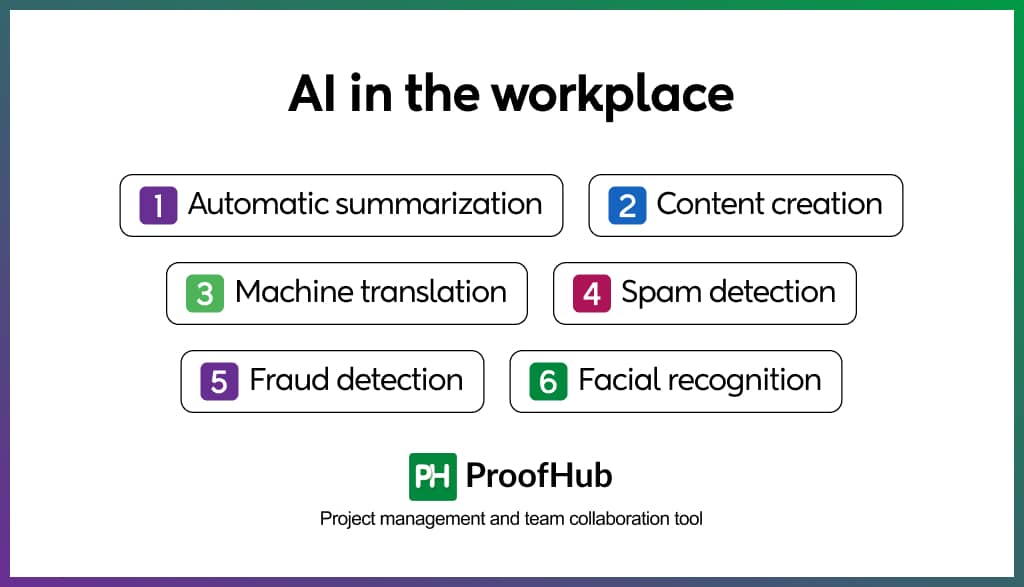
1. Automatic summarization
AI-driven text summarization tools help businesses extract key details and information from overwhelming and complex data sets. The technology is highly suitable for professionals who play with large volumes of numbers and data and require consumable summaries for seamless operations. Some of the examples include legal industries, media houses, and education sectors.
2. Content creation
Generative AI platforms, like Open AI’s ChatGPT and Google’s Bard, are conversational assistants. From writing social media posts, blogs, and ad copy to getting sophisticated and professional emails written for stakeholders, you need to be specific.
An example of a good ChatGPT prompt is
“Suppose you are a social media manager of an X company. You need to write a compelling marketing copy for [insert product/service/company name] targeting [target audience]. Write in an upbeat and friendly tone.”
Marketing agencies, publishing sectors, and e-commerce businesses are some industries using AI for content creation.
3. Machine translation
You may have seen some foreign websites translating entire website content into English or some other preferred language with the click of a button. Well, AI-based translation is behind this capability.
Global businesses across the world use this technology to break down language barriers and expand their business roots. Similarly, tourism industries, educational institutions, and online retail services translate emails, presentations, and docus into multiple languages.
4. Spam detection
AI is also trained to prevent spam emails from weeding your email inboxes. It is trained on data sets, utilizing which it differentiates between spam and legitimate emails. As a result, you are protected from phishing attacks, cluttered inboxes, and malware. Many businesses use these systems to prevent their email repository from turning into a spam junkyard.
5. Fraud detection
AI is well-versed in monitoring transactions to identify suspicious patterns and safeguard from any fraudulent activities. This helps businesses, banks, and financial institutions enhance the security standards of their online transactions.
According to a case study published on Datavisor’s website, Datavisor (fraud & risk defending website) claims that it helped a large federal credit union bank uncover 36% of risky transactions. This further reduced their false positives, simplified decision-making, and strengthened their ROI.
These AI technologies are more impactful compared to traditional methods, preventing consumers from encountering any financial losses.
6. Facial recognition
Facial recognition is no longer limited to identity. In fact, businesses have adopted this technology in their operations, and the facial recognition attendance system is one such example of it. This system eliminates constant attendance tracking, time monitoring, buddy punching, and human error, leading to increased operational efficiency. Apart from that, the technology is extremely beneficial for ensuring authorized access control in workplaces.
Concerns around AI: reality or myth?
Let’s face it – there are some concerns or challenges associated with the use of generative AI in the modern workspace.
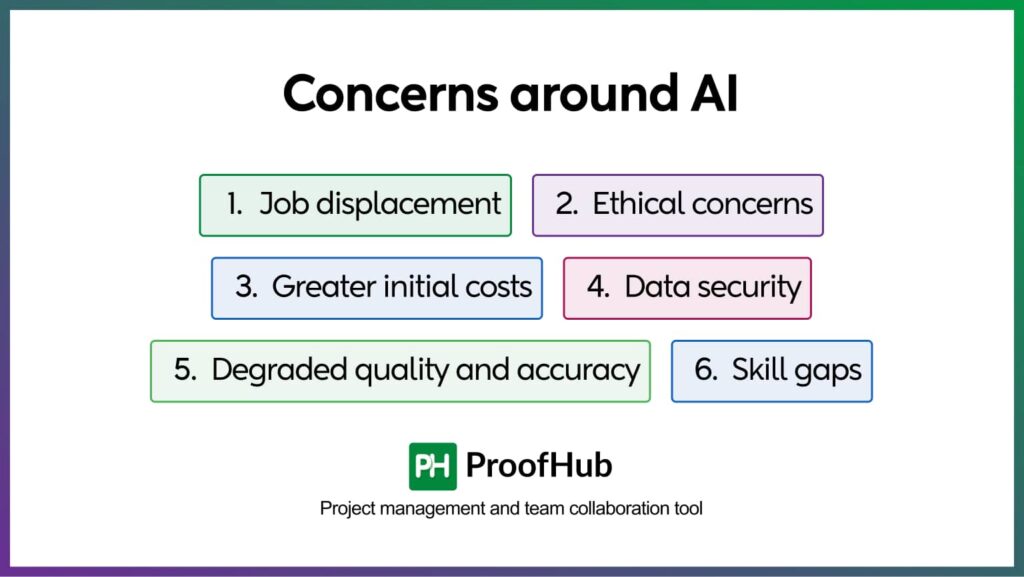
1. Job displacement
There are some valid concerns about losing jobs to AI. Is it a myth? Not entirely. Because, as per a survey, 37% of the companies currently using AI (53%) accepted that in the year 2023, they replaced several employee roles with AI.
However, that’s just one side of the coin. There will also be a surge of new jobs. A study by McKinsey Global Institute backs up the fact that AI could create 20 million to 50 million jobs globally by 2030.
In my opinion, and considering AI turning more operationally efficient, staying adaptable is the key. You need to learn new skills to stay relevant in the evolving landscape.
2. Ethical concerns
AI is trained on data. Like it or not, there has always been a conspiracy behind consumer data privacy and security. That’s a major issue.
With no transparent guidelines behind data usage and no informed consent, trusting AI is tricky. It can even lead to discriminatory outcomes. Also, 53% of organizations agree with ethical concerns of AI being a major issue that forces them to question its efficiency.
3. Greater initial costs
Initial AI implementation costs can be expensive in terms of integration, infrastructure, and training. Why? Because it requires specialized expertise, hardware, and software applications. However, the potential profits and return on investment are worth considering before making your decision.
4. Data security
As long as we lack transparency over data utilization in AI training, we cannot overstate the security risks and potential misuse associated with data. Just because we cannot get into behind the curtains, doesn’t mean the issue isn’t there.
I recently polled my LinkedIn network to see what’s top-of-mind when it comes to implementing AI solutions.
With 39% of votes, security risks emerged as the biggest concern for AI implementation.
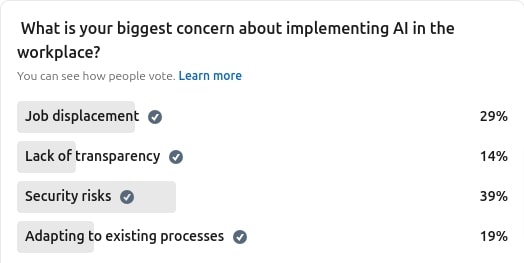
Any malicious actor can bypass security measures for targeted security attacks. They could easily misuse the sensitive information to inject vulnerabilities into the system. Many companies like Amazon, Samsung, and even AI backer Google, have warned employees about sharing confidential information with chatbots in the past.
5. Degraded quality and accuracy
Even AI is prone to provide outdated information. Like even a few days back, Open AI‘s Chat GPT was trained on data till 2022. And for a long, it made decisions based on the past, leading to questionable relevance and reliability.
However, with ChatGPT 4.0, accurate updates and facts, no longer remain an issue. As it has been retrained on more recent data. So, it’s a myth now.
However, no matter the advances, human intervention and oversights are necessary to validate the output. There is no question about it.
6. Skill gaps
We were not prepared for computers when they first arrived. But we learned it over time. The same is true for AI emergence as the current employee base is not AI-ready. It is a problem.
According to APA’s 2023 Work in America survey, 64% of individuals worry about AI making their job duties obsolete in the future. Despite the severity of the issue, people can work alongside AI through constant reskilling and upskilling.
Learn everything about AI project management with our complete guide
Benefits of AI in the workplace
AI is poised to make its ever-lasting integration into the business landscape. Despite the persistent conspiracies around AI’s adoption, the positive workplace impact of artificial intelligence is undeniable.
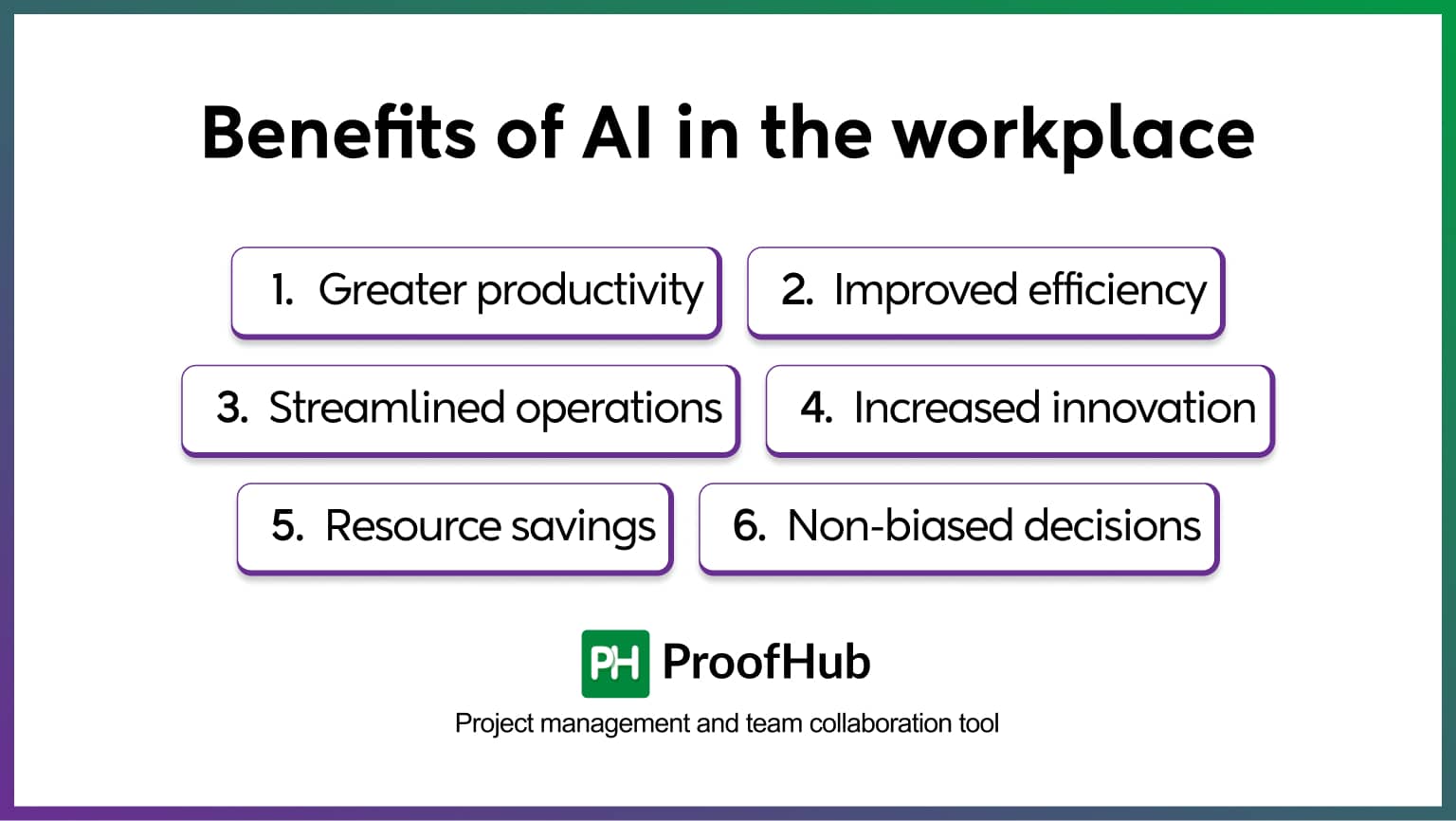
Here are some of the key benefits of AI in the workplace:
1. Greater productivity
Workplace productivity levels soar with the implementation of AI. It does so by taking over mundane tasks, automating recurring ones, and assisting in generating creative ideas.
According to tech.co’s Impact of Technology on the Workplace report, that 72% of respondents who make extensive use of AI report high organization productivity, compared to 51% of organizations who don’t use it at all.
Also, the surplus rise of productivity even brings a 4-day workweek closer to reality. As 93% of businesses considering themselves proficient with AI, indicate that they can consider implementing this flexible approach to their business.
Discover the practical ways to boost workplace productivity and take it to the next level
2. Improved efficiency
AI improves business effectiveness with its precision and 24/7 service for business well-being. For example, you can employ AI to stay on top of transactions in real-time to discover any fraudulent activities. It will handle this job, with utmost swiftness, precision, and effectiveness, eliminating the scope of encountering costly errors. Your employees don’t have to strain to detect anomalies.
3. Streamlined operations
Businesses witness improved workflow management and streamlined operations with AI steering the wheel. Market trends forecasting, round-the-clock customer support, customer base segmentation, marketing campaign personalization, and manual task automation – all are AI-driven chores for facilitating smooth running operations.
4. Increased innovation
AI can help you stay competitive in an evolving market space by forecasting market statistics and customer demands. You can utilize the information to have brainstorming sessions with AI and eventually utilize these creative recommendations to create innovative products. Content creation and social media management teams are the main beneficiaries.
5. Resource savings
AI implementation cuts down unnecessary resource utilization, rising waste, and operational costs. By using predictive analysis, you can reduce downtimes and optimize your workflows. According to Bain & Company’s 2023, The Augmented Workforce Report, workplace augmentation has led to a 21-30% cost reduction.
6. Non-biased decisions
Human bias is one major factor that AI completely wipes out from the picture. However, if AI is fed on biased data, you cannot save personal biases from plaguing the outcome. Because AI is not inherently biased.
However, you can mitigate these risks by implementing techniques like debiasing algorithms, adversarial training, and fairness constraints. Human resource management and talent management can benefit from this AI capability.
How do you prepare for the rise of AI?
If you want your team to stay current with the latest happenings in the AI world, you need to step up proactively.
You can do that by:
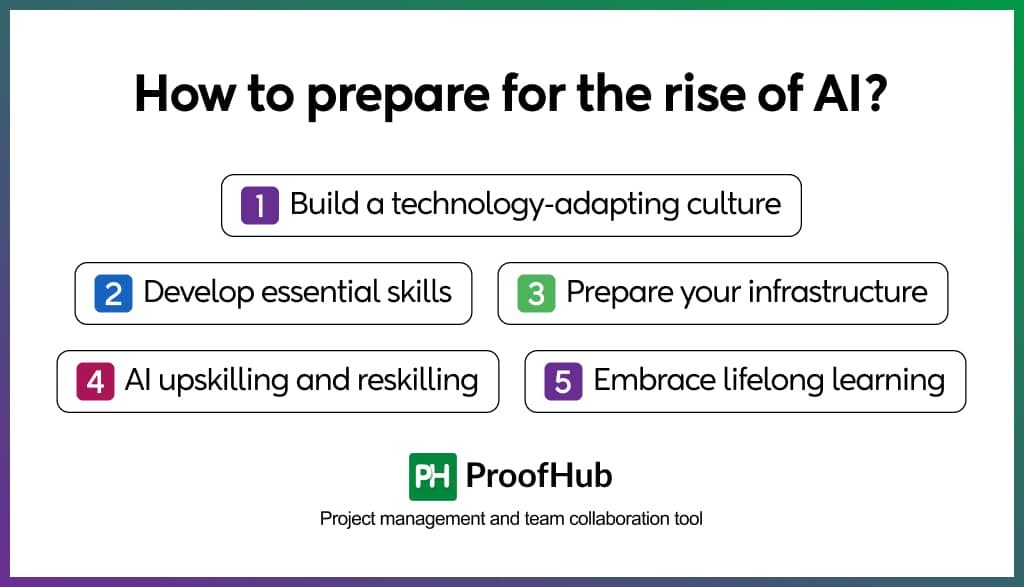
1. Build a technology-adapting culture
You can’t expect your employees to embrace AI adoption on their own. They will engage only when you provide them the ground to play on. To encourage them to test the waters, educate them on potential opportunities- and not negative consequences.
Show them how by staying ahead of the curve, they can ensure job security in the future. Support them on their journey to exploration, as when your team feels empowered, they won’t hesitate to experiment with AI.
2. Develop essential skills
While you might have heard people saying, AI won’t ever be able to replicate human creativity and lacks empathy. Well, consider the myth bursting now after the release of OpenAI’s latest GPT-4o (“Omni”) model, which emphasizes more organic human-computer interactions.
Hemant Mohapatra, partner at venture capital firm Lightspeed says, “It seems OpenAI has built an audio foundation model ground up – the model can sing, change tones, speak slow or fast, understand your emotions, and respond appropriately.”
So, during this changing landscape, no matter your role, focusing on developing new skills is crucial. Some key areas to strengthen your command and stay competitive are:
- Data analysis
- Machine learning
- Technical skills
- Critical thinking
- Ethical compliance
- Human-AI interaction
Never stay behind with the 9 essential skills for project managers to stay relevant in the AI era
3. Prepare your infrastructure
Just because everybody is hopping on the trend train, doesn’t mean you have to jump on the board right away. It’s okay to be late to the party, than not go at all. (That’s my favorite go-to line)
“There’s much solid foundation work that needs to be done before AI can make a difference.” – Jason Averbook, co-founder and CEO of consulting firm Leapgen
The same is the case with AI implementation. Before introducing it to your business directly, prepare your infrastructure for the AI implementation. Identify the gaps in your current tech stack, hardware, software, and network capabilities. Evaluate the quality, amount, and variety of the data, required to instruct the generative AI.
4. AI upskilling and reskilling
Want to leverage the full potential of AI – Prepare a dedicated program for reskilling and upskilling your employee base. Identify the roles that AI will impact to a minor or major extent. Offer them the right resources, training, and mentorship, to ensure smoother adoption, successful integration, and eventually, a seamless transition process. Make employees understand AI’s impact, potential, and opportunities to bring everyone to a mutual consensus and stay adaptable.
5. Embrace lifelong learning
AI is reshaping its interface with every passing day. So can you keep up with the trend of staying stagnant in your approach? No. Instead, you need to motivate your team to stay updated on emerging technologies.
Ravi Ramamurti, Northeastern University’s distinguished professor of international business emphasizes the need to hire workers versed in business applications and technology by saying, “To get there, companies will have to invest heavily in training employees, and employees will have to embrace lifelong learning.”
Empower employees to embrace online platforms, courses, resources, and workshops to stay adaptable toward possible future technologies. It will help in their future growth as well as continuous organizational improvement.
The future of AI in the workplace
AI is shaping the future of work with every passing day. But has it reached its peak? No, it’s not the case. It’s just the beginning, and the rise is exponential.
Despite the growing concerns around the AI revolution, the shift is continually going to redefine how we work. It is a realm of endless possibilities, where we need to be ever ready to get an edge. Only by embracing innovation can we allow AI to augment our potential and create digitally mature organizations.
FAQs
What is the future of AI in the workplace?
The partnership of AI and the workplace isn’t limited to business automation. Instead, it is open to endless opportunities, such as the rise of specialized AI tools, explainable AI, and human-AI partnerships are some exciting developments you can witness as AI continues to evolve.
Is using AI in the workplace bad?
Integrating AI-driven solutions in the workplace isn’t inherently bad. It offers various benefits to businesses to enhance effectiveness and efficiency. However, it does have downsides which if avoided can lead to unforeseen challenges.
How will AI improve the workforce?
AI holds the remarkable capability to provide numerous benefits to workspaces. By automating recurring tasks, analyzing information efficiently, and optimizing workflow, AI lets workspaces enjoy heightened productivity, enhanced engagement, streamlined operations, and more.
